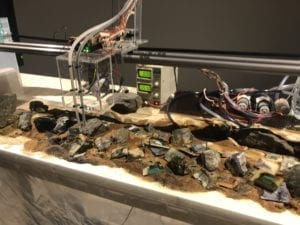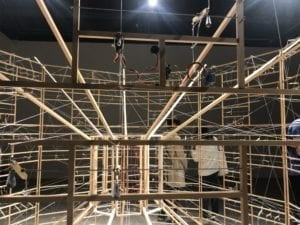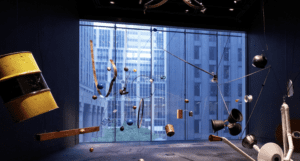The Chronus Exhibition created an art experience that blended both technology and artistic vision. Each individual piece had an interactive element along with an artistic message and interpretation. The pieces allowed the audience it come to their own conclusion about each piece and then after reading the artist’s explanation learn the intention of the peace. For instance,the Test Execution Host by Martin Howse, first appeared more like an environmental statement mixed with the current state of technology as a machine dispelled a dark liquid mixture and water on to pieces of technology that were placed in sand. However, rather than my assumption of the meaning of this piece, the artist’s intentions where focused around the ones and zeros of computer systems, taking a physical look and representation of a normally digital occurence of ones and zeroes. In addition to T.E.H.,I also closely observed the large wooden structure comprised of servo motors, strings, and more called Rechender Raum by Ralf Baecker. This piece acted like an inside-out or transparent machine.The first thing this piece reminded me of was a brain, what the artist later called a neural network, each connection being connected by strings that the servo motor controlled. At first, I only recognized the outside walls changing in movement and shape as each different string was pulled. Only after a while did I notice the center of the machine moving and changing shape based on all the outside manipulations, each working in tandem to create the center shape. This piece I understood much better than the T.E.H. before looking at the artists own interpretation.

Test Execution Host by Martin Howse

Rechender Raum by Ralf Baecker
Compared to most of my experiences at art exhibitions before, this exhibition differed on it’s centrality around technology and its interactive function. Most art museums that I have been to like MOMA, the Louvre, or the Metropolitan consist of art exhibits that are interactive in the sense of engaging the audience with their views and interpretations and making the audience think deeper about a topic or idea, but those exhibitions normally do not involve any movement or programing. For instance, one of my favorite exhibits at the Met is their Costume Institute, which displays many historical costumes from all over the world from different time periods. Each costume is beautiful and kept mostly in their own glass box. Their audience is however, limited to exclude the general public and is very restrictive for the sake of keeping the textiles in tact. The pieces each elicit emotions, contemplation, and mindful participation from their audience, but they do not involve direct interaction between the two parties and do not move or have programming of their own. The information about these costumes however is more interactive, using an electronic interactive screen system to allow the audience to learn more about particular pieces. Many museums that carry the conventional style of physical art and visual art, now also include a technology component for a more interactive and experiential learning moment. MOMA currently has an a quite interactive art exhibit focusing around noise and sound, David Tudor and Composers Inside Electronics Inc., Rainforest V (variation 1). This exhibit is however for focused around live art rather than technology mixing with art and interactions. Most non-technology based art exhibits, excluding live performance are less interactive in the basic understanding of two actors with inputs, processing, and output, and more interactive on a scale of contemplation and making the audience think about a work as an experience.
 Rainforest V (variation 1)
Rainforest V (variation 1)
We present a novel 3D display that applies projection mapping to a non-planar and reconfigurable fog screen, thus enabling interactive visual contents to be displayed at multiple depth levels. Users can perceive three-dimensionality naturally and interact with the unencumbered images by touching them directly in mid-air. The display can also be used in mixed reality settings where physical objects can co-exist and interact with virtual objects in physical space in real time. It does not require special glasses, head-mounted devices or eye/head-tracking, while allowing high-resolution, full-color 3D image to be observed from wide viewing angles by many people at the same time. Most importantly, our immaterial, mid-air display will allow users to intuitively touch and manipulate virtual objects in 3D under marker-free and barrier-free settings, which will open up immense tangible and creative interaction possibilities. This interactive experience is highly successful with its user-friendly interface and wide range of uses and interactions. LUMENS LED Panels at Cabrini Hospital Malvern is a less successful interactive art piece because although it is labeled interactive, their focus is mainly reactive. This art piece is an LED lit wall that screens different pixelated images which run whenever they are activated by a person whenever they walk by. In theory this is an interactive element that includes some sort of motion sensor whether it be infrared or something else. However, the LED display does not change or react based on the other participants movement, and does not create any complex and thoughtful interaction like a message or contemplation. Comparatively to the volumetric fog display, this LED screen is quite reactive allowing one side, the people, to participate in the interaction but the display runs on loop with preset images that don’t change.
My original definition of interaction for the group project was very rigid, including two actors and input, processing, and output. After reading What Exactly is Interactivity? , I defined interaction as involving two actors, which have an input, processing, and output. The author uses the analogy of one actor speaking and then the other listening, thinking, and reacting(5). The author also explained interaction as having levels of complexity. During the midterm project, I expanded my definition of interaction to involve the interaction of an experience, specifically the audiences thinking, contemplation, and experience of a greater theme or message. In our midterm project, my partner and I considered the experience a large part of our interaction, so we hung out piece from the ceiling to change the perspective and we used large themes about the environment and human’s consumption habits to spark greater contemplation, beyond the physical project itself. Now as I look back on those pieces of the interactive definition, I would like to clarify the different levels of interaction. There can be interaction, especially with interactive art that includes limited physical interaction. However, projects like the volumetric fog display allow for very complex and 3D physical interaction between the audience and the piece, which can create infinite outcomes of different drawings and different ideas only constrained by space, time, and human creativity. This personally, I see as a complex successful interactive experience that is ever changing as the audience is ever changing. Interactive experiences and projects can also be successful if they are engaging with the audience’s mind and thinking about how certain concepts work like the Chronus Exhibition pieces, specifically Rechender Raum and also what we strive to accomplish in our midterm project at a smaller level. However, the ultimate level of interaction comes from the interactive project being able to interact with many different users and have an easy to understand/ intuitive interaction. The volumetric fog display was extremely intuitive and user-friendly. Even some of the Chronus Exhibition pieces although interactive and extremely interesting were less intuitive as many students tried to touch the different art pieces where they were actually supposed to just observe them. Integrating the definition of interactive art based on TATE, interactive art was also a method for the artists to connect better with the environment and their audience, enhancing both the interactive elements coming from the audience and from the machine/art piece designed by an artist with intentions for certain interactions. Cumulatively, a successful interactive experience consists of two actors that communicate through a series of inputs, processing, and output, but the overall experience created also qualify as an enhance an interaction including forcing the audience to think deeper about a specific issue or concept. Interactive experiences exist at different levels of interaction some including for physical or more mental interaction and some including both.